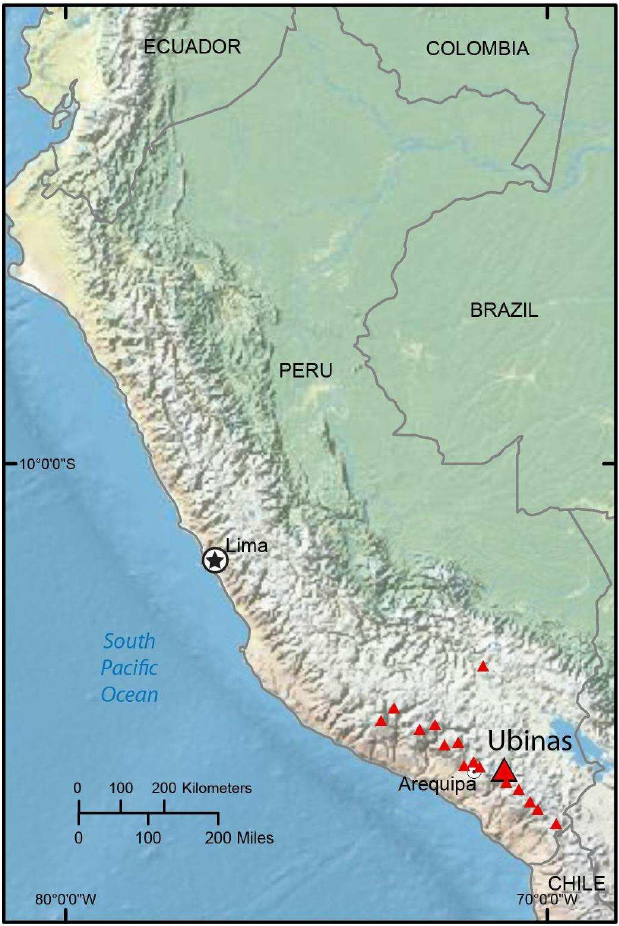Description

Disclaimer: Copyright infringement not intended.
Context
State of emergency was declared in Peru's Moquegua region due to the activity of the Ubinas volcano.
Details
- Peru's Moquegua region has declared a state of emergency due to ongoing activity of the Ubinas volcano.
- The volcano has been spewing ash and experiencing numerous explosions in the past two days.
- President Alberto Otarola declared an emergency, stating that the Ubinas volcano has entered an "eruptive process."
Volcano Activity and Impact
- The Ubinas volcano, located in the southern Andean region, began emitting ash onto surrounding villages on Tuesday.
- The volcano had been inactive since 2019.
- The ash plume reaches an altitude of approximately 5,000 meters (16,404 feet) and is carried by the wind to nearby villages.
- The eruption is likely to impact approximately 2,000 people living in the vicinity.
- The ash has covered houses and streets in nearby villages, prompting precautionary measures.
Precautionary Measures
- Residents have been advised to remain indoors to prevent inhaling the ash.
- The advisory will be in effect for the next two months.
- Local authorities have not issued evacuation orders yet, but federal agencies are making preparations by setting up shelters.
Geographical Context
- The Ubinas volcano is part of a group of seven volcanoes in southern Peru within a volcanic zone extending from southern Peru to northern Chile.
- The affected area is situated within the "Ring of Fire," known for its volcanic activity and seismic events.
Previous Eruptions and Volcanic Region
- During the eruption of Ubinas in 2019, hundreds of people were evacuated from the area.
- Historical records indicate that Ubinas has experienced around 25 eruptions since 1550.
- The regions of Moquegua, Arequipa, and Tacna, along with their neighboring areas, are home to approximately 40 volcanoes, with the majority currently dormant.

About Peru
- Peru is a country located in western South America, bordering the Pacific Ocean to the west.
- It shares borders with Ecuador, Colombia, Brazil, Bolivia, and Chile.
- The country has a diverse landscape, including the Andes Mountains, the Amazon rainforest, and coastal regions.
- Peru has a population of approximately 32 million people, with Lima being the capital and largest city.
Cultural and Historical Significance
- Peru has a rich cultural heritage, with ancient civilizations such as the Inca Empire leaving significant historical landmarks and artifacts.
- Machu Picchu, a UNESCO World Heritage Site, is an iconic symbol of Inca civilization and a popular tourist attraction.
- The country is known for its vibrant traditional festivals, music, and cuisine, including ceviche and the famous Peruvian dish, Cuy (guinea pig).
Economy and Industries
- Peru has a mixed economy with a diverse range of industries.
- It is a leading producer of minerals such as copper, gold, silver, and zinc, contributing significantly to its export revenue.
- Agriculture is also important, with Peru being a major exporter of products like coffee, asparagus, and quinoa.
- The tourism sector plays a significant role, attracting visitors with its archaeological sites, natural wonders, and cultural experiences.
Environmental Diversity and Biodiversity
- Peru is home to a remarkable range of ecosystems due to its diverse geography.
- The Amazon rainforest covers a significant portion of the country, hosting a wide array of plant and animal species.
- The Andes Mountains are characterized by high-altitude landscapes and unique flora and fauna.
- Peru is considered one of the world's megadiverse countries, with abundant biodiversity and endemic species.
Challenges and Conservation Efforts
- Peru faces environmental challenges such as deforestation, illegal mining, and habitat degradation.
- Efforts are being made to promote sustainable practices, protect natural areas, and support indigenous communities.
- The country has established numerous national parks, reserves, and protected areas to safeguard its natural heritage.
Cultural and Ethnic Diversity
- Peru is a multicultural country with a rich blend of indigenous, European, African, and Asian influences.
- Indigenous communities, including Quechua and Aymara, contribute to the country's cultural diversity.
- Spanish is the official language, but Quechua, Aymara, and other indigenous languages are also spoken.
|
PRACTICE QUESTION
Q) Match the following:
| Type of volcano |
Characteristics |
| 1.Cinder cones |
A. made from high-viscosity lava, ash and rock debris. |
| 2.Lava Domes |
B.eruptions of mostly small pieces of scoria and pyroclastics |
| 3.Composite |
C. eruption of low-viscosity lava that can flow a great distance from vent. |
| 4.Shield |
D.built by slow eruptions of highly viscous lava. |
Select the correct answer using the codes below:
(A) 1- A, 2- C, 3-B, 4-D
(B) 1-C, 2-B, 3-D, 4-A
(C) 1-D, 2-B, 3-A, 4-C
(D) 1-B, 2-D, 3-A, 4-C
Answer: D
|

https://www.republicworld.com/world-news/south-america/perus-ubinas-volcano-spews-smoke-and-ash-emergency-declared-in-moquegua-articleshow.html











